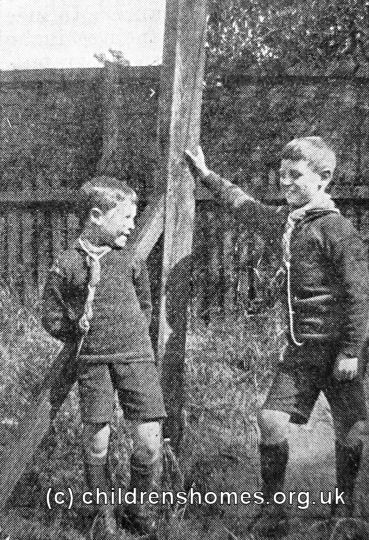Victoria Home, Formby, Liverpool, Lancashire
In 1897, the Waifs and Strays Society established its Victoria Home for Infants at 46 Andrew's Lane, Formby, near Liverpool. The purpose-built premises, which cost around £2,000, were designed by the Liverpool architect, Mr J Havelock Sutton. The location of the home is shown on the 1927 map below.

Victoria Home site, Liverpool, c.1927.

Victoria Home, Formby, Liverpool, early 1900s. © Peter Higginbotham
The official opening of the home, on April 24th, 1897, was performed by a local supporter of the Society, Mrs J.S. Beauford, standing in for the Countess of Lathom who had had a severe fall. The Bishop of Liverpool then performed a service of benediction, naming the home in honour of the golden jubilee of Queen Victoria, which also place in 1897. The home, described as a 'children's place', could accommodate 30 children aged from 2 to 7, although older children were occasionally admitted.

Victoria Home, Formby, Liverpool, c.1925. © Peter Higginbotham
The first matron was Miss Bratt, who held the post until 1910. When she left, Society's newsletter recorded taht that 'her loving care of the little ones, her bright, cheerful disposition and the ready welcome she always extended to all who visited the Home, will ever find a warm place in our memories'. Mrs Beauford, who was President of the Home's Committee until her death in 1923, organised many fundraising events on behalf of the children including their popular annual ball.

Victoria Home, Formby, Liverpool, c.1914. © Peter Higginbotham
As at other children's establishments, membership of local Boy Scouts and Wolf Cubs groups was a popular activity with the Victoria Home boys.

Wolf Cubs at Victoria Home, Formby, Liverpool, c.1925. © Peter Higginbotham
From 1945 to 1947, the home operated as the Victoria Home For Toddlers. After the toddlers were transferred to the new Francis Pochin Nursery at Southport, the Victoria Home received the girls from former Galloway Home at Whalley Range. The home became mixed in 1960. In 1973, it became an Assisted Community Home.
The home finally closed in 1981. The building no longer survives and modern housing now occupies the site.
Records
Note: many repositories impose a closure period of up to 100 years for records identifying individuals. Before travelling a long distance, always check that the records you want to consult will be available.
- Index of the Society's first 30,000 children's case files ordered by surname.
- Index of the Society's first 30,000 children's case files ordered by date of birth.
- The Children's Society Records and Archive Centre is at Unit 25, Springfield House, 5 Tyssen Street, London E8 2LZ (email: archives@childrenssociety.org.uk). Files for children admitted to its homes after September 1926 were microfilmed in the 1980s and the originals destroyed. Some post-1926 files had already been damaged or destroyed during a flood. The Society's Post-Adoption and Care Service provides access to records, information, advice, birth record counselling, tracing and intermediary service for people who were in care or adopted through the Society.
- The Society has produced detailed catalogues of its records relating to disabled children, and of records relating to the Children's Union (a fundraising body mostly supported from the contributions of children).
Bibliography
- Bowder, Bill Children First: a photo-history of England's children in need (1980, Mowbray)
- Church of England Waifs and Strays' Society [Rudolfe, Edward de Montjoie] The First Forty Years: a chronicle of the Church of England Waifs and Strays' Society 1881-1920 (1922, Church of England Waifs and Strays' Society / S.P.C.K.)
- Higginbotham, Peter Children's Homes: A History of Institutional Care for Britain's Young (2017, Pen & Sword)
- Morris, Lester The Violets Are Mine: Tales of an Unwanted Orphan (2011, Xlibris Corporation) — memoir of a boy growing up in several of the Society's homes (Princes Risborough, Ashdon, Hunstanton, Leicester) in the 1940s and 50s.
- Rudolf, Mildred de Montjoie Everybody's Children: the story of the Church of England Children's Society 1921-1948 (1950, OUP)
- Stroud, John Thirteen Penny Stamps: the story of the Church of England Children's Society (Waifs and Strays) from 1881 to the 1970s (1971, Hodder and Stoughton)
Links
- Hidden Lives Revealed — the story of the children who were in the care of The Children's Society in late Victorian and early 20th Century Britain.
- The Children's Society
Except where indicated, this page () © Peter Higginbotham. Contents may not be reproduced without permission.


